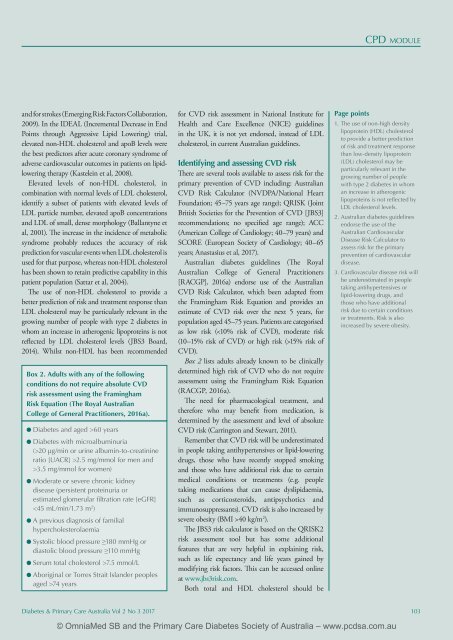DPCA 2-3_100-110_wm
You also want an ePaper? Increase the reach of your titles
YUMPU automatically turns print PDFs into web optimized ePapers that Google loves.
CPD module<br />
and for strokes (Emerging Risk Factors Collaboration,<br />
2009). In the IDEAL (Incremental Decrease in End<br />
Points through Aggressive Lipid Lowering) trial,<br />
elevated non-HDL cholesterol and apoB levels were<br />
the best predictors after acute coronary syndrome of<br />
adverse cardiovascular outcomes in patients on lipidlowering<br />
therapy (Kastelein et al, 2008).<br />
Elevated levels of non-HDL cholesterol, in<br />
combination with normal levels of LDL cholesterol,<br />
identify a subset of patients with elevated levels of<br />
LDL particle number, elevated apoB concentrations<br />
and LDL of small, dense morphology (Ballantyne et<br />
al, 2001). The increase in the incidence of metabolic<br />
syndrome probably reduces the accuracy of risk<br />
prediction for vascular events when LDL cholesterol is<br />
used for that purpose, whereas non-HDL cholesterol<br />
has been shown to retain predictive capability in this<br />
patient population (Sattar et al, 2004).<br />
The use of non-HDL cholesterol to provide a<br />
better prediction of risk and treatment response than<br />
LDL cholesterol may be particularly relevant in the<br />
growing number of people with type 2 diabetes in<br />
whom an increase in atherogenic lipoproteins is not<br />
reflected by LDL cholesterol levels (JBS3 Board,<br />
2014). Whilst non-HDL has been recommended<br />
Box 2. Adults with any of the following<br />
conditions do not require absolute CVD<br />
risk assessment using the Framingham<br />
Risk Equation (The Royal Australian<br />
College of General Practitioners, 2016a).<br />
l Diabetes and aged >60 years<br />
l Diabetes with microalbuminuria<br />
(>20 µg/min or urine albumin-to-creatinine<br />
ratio [UACR] >2.5 mg/mmol for men and<br />
>3.5 mg/mmol for women)<br />
l Moderate or severe chronic kidney<br />
disease (persistent proteinuria or<br />
estimated glomerular filtration rate [eGFR]<br />
7.5 mmol/L<br />
l Aboriginal or Torres Strait Islander peoples<br />
aged >74 years<br />
for CVD risk assessment in National Institute for<br />
Health and Care Excellence (NICE) guidelines<br />
in the UK, it is not yet endorsed, instead of LDL<br />
cholesterol, in current Australian guidelines.<br />
Identifying and assessing CVD risk<br />
There are several tools available to assess risk for the<br />
primary prevention of CVD including: Australian<br />
CVD Risk Calculator (NVDPA/National Heart<br />
Foundation; 45–75 years age range); QRISK (Joint<br />
British Societies for the Prevention of CVD [JBS3]<br />
recommendations; no specified age range); ACC<br />
(American College of Cardiology; 40–79 years) and<br />
SCORE (European Society of Cardiology; 40–65<br />
years; Anastasius et al, 2017).<br />
Australian diabetes guidelines (The Royal<br />
Australian College of General Practitioners<br />
[RACGP], 2016a) endorse use of the Australian<br />
CVD Risk Calculator, which been adapted from<br />
the Framingham Risk Equation and provides an<br />
estimate of CVD risk over the next 5 years, for<br />
population aged 45–75 years. Patients are categorised<br />
as low risk (15% risk of<br />
CVD).<br />
Box 2 lists adults already known to be clinically<br />
determined high risk of CVD who do not require<br />
assessment using the Framingham Risk Equation<br />
(RACGP, 2016a).<br />
The need for pharmacological treatment, and<br />
therefore who may benefit from medication, is<br />
determined by the assessment and level of absolute<br />
CVD risk (Carrington and Stewart, 2011).<br />
Remember that CVD risk will be underestimated<br />
in people taking antihypertensives or lipid-lowering<br />
drugs, those who have recently stopped smoking<br />
and those who have additional risk due to certain<br />
medical conditions or treatments (e.g. people<br />
taking medications that can cause dyslipidaemia,<br />
such as corticosteroids, antipsychotics and<br />
immunosuppressants). CVD risk is also increased by<br />
severe obesity (BMI >40 kg/m 2 ).<br />
The JBS3 risk calculator is based on the QRISK2<br />
risk assessment tool but has some additional<br />
features that are very helpful in explaining risk,<br />
such as life expectancy and life years gained by<br />
modifying risk factors. This can be accessed online<br />
at www.jbs3risk.com.<br />
Both total and HDL cholesterol should be<br />
Page points<br />
1. The use of non-high density<br />
lipoprotein (HDL) cholesterol<br />
to provide a better prediction<br />
of risk and treatment response<br />
than low-density lipoprotein<br />
(LDL) cholesterol may be<br />
particularly relevant in the<br />
growing number of people<br />
with type 2 diabetes in whom<br />
an increase in atherogenic<br />
lipoproteins is not reflected by<br />
LDL cholesterol levels.<br />
2. Australian diabetes guidelines<br />
endorse the use of the<br />
Australian Cardiovascular<br />
Disease Risk Calculator to<br />
assess risk for the primary<br />
prevention of cardiovascular<br />
disease.<br />
3. Cardiovascular disease risk will<br />
be underestimated in people<br />
taking antihypertensives or<br />
lipid-lowering drugs, and<br />
those who have additional<br />
risk due to certain conditions<br />
or treatments. Risk is also<br />
increased by severe obesity.<br />
Diabetes & Primary Care Australia Vol 2 No 3 2017 103<br />
© OmniaMed SB and the Primary Care Diabetes Society of Australia – www.pcdsa.com.au
















